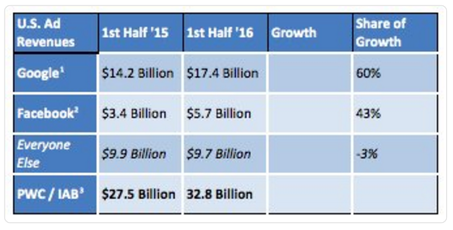Menu
The 'consumer boycott' of web advertising is gaining momentum |

When you open a page in your browser, you’re likely interacting with hundreds of web servers. A U.S. Senate investigation of online advertising conducted in 2014 found that going to one “tabloid” news site resulted in 352 separate server interactions. Any of those 352 servers could have been serving up malware in the guise of advertising.
In an October 31, 2016, article on Bank Info Security, Jeremy Kirk writes that computer criminals are finding web ad networks an easy and accessible mechanism for delivering their ransomware and other malicious payloads. In just one month in 2014, Google disabled 400,000 ads on its network that were infected with malware. These malicious ads infect your machine without you having to click anything; simply opening the page that hosts the ads is sufficient to deliver their malware. All a criminal has to do to infiltrate one of the thousands of web ad networks currently operating is to make a minimal effort to look like a legitimate business. Sometimes it’s as easy as creating a fake LinkedIn or Facebook page, and often even these simple steps are unnecessary to trick the ad networks, according to Kirk. The digital ad industry association called the Trustworthy Accountability Group recently published voluntary guidelines to help its member advertisers detect and remove malware from their networks. Kirk speculates that the U.S. Federal Trade Commission may regulate the ad industry to ensure it is protecting consumers from malware that steals private data or extorts money by blocking access to the information. Kirk claims the FTC has filed 60 enforcement actions recently against companies for failing to protect their customers’ data. Malware prevention costs money ad networks aren’t willing to spend The web-ad universe has become so complicated it’s a challenge just knowing where a particular ad originated, let alone how it came to appear on your computer or phone. Consider the crucial role of the referral tags, which are snippets of HTML code that send information about you to the ad network. Based on that information, the network delivers an ad that it calculates will be of interest to you. This is how ad networks target you. The ad comes from a third party, so the site you’re on doesn’t know anything about the ad, including where it originated. The referral tags are constantly changing, which presents an opportunity for malware. It’s difficult to scan all this traffic for potential security threats, and nearly impossible to prevent infection through social engineering. Criminals imitate legitimate businesses, similar to the fake apps that have been infiltrating the Apple Store, as Mashable’s Karissa Bell reports in a November 7, 2016, article. Ad blockers become a form of ad-network boycott Doc Searls starting calling the use of ad-blocking browser extensions a form of boycott in a post from September 28, 2015. (In fact, Searls credits his wife with coming up with the analogy.) Searls graphs the popularity of “do not track” compared to out-and-out ad blocking in recent years, which shows the former losing ground and the latter growing in popularity. Searls concludes by comparing the ad-blocking trend to “GandhiCon,” the four “stages of establishment resistence to a winning strategy of nonviolent activism”:
As Searls sees it, ad blocking is currently at GandhiCon 3. --------------------------------------------------------------------------- Facebook and Google take the lion’s share of online ad revenue Who are those web ads benefitting? When Jason Kitt of the Digital Content Next trade group analyzed revenue numbers from the Interactive Advertising Bureau and found that Google recorded $17.4 billion in revenue from ads in the first half of 2016, Facebook made $5.7 billion in ad revenue in the period, and all other companies combined brought in $9.7 billion from ads in the first half of the year. Recode’s Peter Kafka takes a closer look at the revenue numbers in a November 2, 2016, article. As the table at the top of this page indicates, Google saw its revenue increase by 60 percent compared to the $14.2 billion recorded in the first half of 2015. Facebook’s ad revenue was 42 percent higher than the $3.4 billion it collected in the year-earlier period. Everybody else’s share declined 3 percent from $9.9 billion the first half of 2015. In other words, the rich get richer. While Google revenue increased 22 percent and Facebook’s a whopping 67 percent, all other web sites saw their revenue go down. According to one estimate, 85 percent of all new expenditures on digital advertising go to either Google or Facebook. The caveat, according to Kafka, is that many of the numbers on which these projections are based boil down to guesses: the IAB revenue counts are compiled via survey, as are some other measures. Still, the analysis by Kitt matches similar data compiled by independent researchers: Google and Facebook are growing revenue, all others combined are shrinking. Investors Business Daily came to the same conclusion about mobile ad revenue based on a report by MoffattNathanson of 2015 digital advertising numbers. Reinhardt Krause writes about the findings in a May 3, 2016, article. According to the report, Google and Facebook account for 54 percent of the total digital-ad market, and 67 percent of the mobile-ad market. In addition, Facebook holds a 65 percent share of the total social ad market; social ads represented 70 percent of the revenue growth for all digital ads in 2015. How bad has it gotten? Some proponents of the AT&T/Time Warner merger argue that such a mega telecom/media company is the only way to prevent Google and Facebook from gaining an insurmountable lead in the digital-media market, as Wired’s Klint Finley reports in an October 22, 2016, article. They may have begun as Internet companies, but Google, Facebook, and Amazon, have joined Netflix as new-media giants who are also becoming telecoms. |
